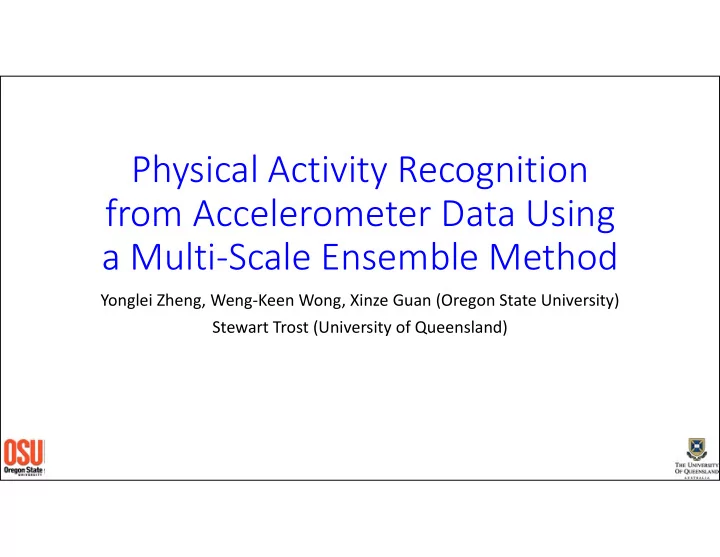

Physical Activity Recognition from Accelerometer Data Using a Multi ‐ Scale Ensemble Method Yonglei Zheng, Weng ‐ Keen Wong, Xinze Guan (Oregon State University) Stewart Trost (University of Queensland)
Introduction • Goal: accurate, objective and detailed measurement of physical activity • Why? Many health related reasons… • Understand relationship between physical activity and health outcomes • Detecting at risk populations • Measure effectiveness of intervention strategies
Introduction • Accelerometers are a cheap, reliable and unobtrusive way to measure physical activity • Capture acceleration in different planes (typically triaxial) • Typically attached at the wrist or hip Actigraph’s GT3X+ accelerometer Dimensions: 4.6cm x 3.3cm x 1.9cm • Weight: 19 g •
Introduction • The challenge: interpreting this data Standing Walking Lying Down / Sitting
Introduction Segment and LiME Data Sample 2 Followup paper (not this classify free ‐ 1.5 talk) 1 living data 0.5 Amplitude 0 0 100 200 300 400 500 ‐ 0.5 ‐ 1 ‐ 1.5 ‐ 2 Time (Seconds) This talk Classify already segmented data Walking Running
Related Work 1. Time series Classification (see Xing, Pei and Keogh 2010) • Nearest neighbor approaches with different distances metrics eg. Euclidean (Keogh and Kasetty 2003), Dynamic time warping (Wang et al. 2010) • Supervised Learning eg. decision trees (Bonomi et al. 2009), neural networks (Staudenmayer et al. 2009), support vector regression (Su et al. 2005), ensembles (Ravi et al. 2005) • Many different representations used eg. symbolic (Lin et al. 2003), shapelets (Ye and Keogh 2009), etc. 2. Segmentation • Hidden Markov Models (Lester et al. 2005, Pober et al. 2006) • Conditional Random Fields (van Kasteren et al. 2008, Gu et al. 2009, Wu et al. 2009)
Introduction Things to note: • Each window of data consists of a single activity • Repetitive pattern • Discriminative features at different scales • Supervised learning approach works very well on our data
Methodology Supervised Learning Approach Cut time series into non ‐ overlapping windows Time Axis Axis Axis Feature Value 1 2 3 16:34:00 191 14 72 X1 0.1 Supervised 16:34:01 36 18 63 learning X2 15 approaches X3 2 16:34:02 6 19 22 … … 16:34:03 21 60 79 … … … …
Methodology Two issues when applying supervised learning to time series data 1. What features to use? • Feature extraction ultimately needs to be efficient • Bag ‐ of ‐ features + regularization works very well
10 Features Axis ‐ 1 Axis ‐ 2 Axis ‐ 3 1. Percentiles: 1. Percentiles: 1. Percentiles: 10 th ,25 th ,50 th ,75 th ,9 10 th ,25 th ,50 th ,75 th ,9 10 th ,25 th ,50 th ,75 th ,9 0 th 0 th 0 th 2. Lag ‐ one ‐ 2. Lag ‐ one ‐ Between two axes 2. Lag ‐ one ‐ autocorrelation autocorrelation autocorrelation 1. Correlation between axis ‐ 1 3. Sum 3. Sum 3. Sum and axis2 4. Mean 4. Mean 4. Mean 2. Correlation between axis ‐ 2 and axis3 5. Standard deviation 5. Standard deviation 5. Standard deviation 3. Correlation between axis ‐ 1 6. Coefficients of 6. Coefficients of 6. Coefficients of and axis3 variation variation variation 7. Peak ‐ to ‐ peak 7. Peak ‐ to ‐ peak 7. Peak ‐ to ‐ peak amplitude amplitude amplitude 8. Interquartile range 8. Interquartile range 8. Interquartile range 9. Skewness 9. Skewness 9. Skewness 10. Kurtosis 10. Kurtosis 10. Kurtosis 11. Signal power 11. Signal power 11. Signal power 12. Log ‐ energy 12. Log ‐ energy 12. Log ‐ energy 13. Peak intensity 13. Peak intensity 13. Peak intensity 14. Zero crossings 14. Zero crossings 14. Zero crossings
Methodology Two issues when applying supervised learning to time series data 1. What features to use? 2. How big of a window? • Too big: features too coarse, high latency of activity recognition • Too small: features meaningless • Need multi ‐ scale approach
Subwindow Ensemble Model Training data {t 1 , t 2 , …, t 10 } Training data {t 1 , t 2 , …, t 6 } Training data {t 1 } from other 10 subwindows from other 6 subwindows from other 1 subwindow time series time series time series Single scale model (1 sec) Single scale model (10 sec) Single scale model (5 sec) Majority Vote Final Prediction 12
Experiments • Datasets • Human Activity Sensing Challenge (triaxial, 100 Hz, 7 subjects, 6 classes) • OSU Hip (triaxial, 30Hz, 53 subjects, 7 classes) • OSU Wrist (triaxial, 30 Hz, 18 subjects, 7 classes) • Experimental Setup • Split by subject into train/validate/test splits • Averaged over 30 splits
Experiments Algorithms 1. 1 ‐ NN (Euclidean distance, DTW) 2. (Single scale) Supervised Learning Algorithms (ANN, SVM) with 10 second windows 3. (Multi ‐ scale) SWEM (SVM) with 10 ensemble members
Results Algorithm HASC OSU Hip OSU Wrist (Macro ‐ F1) (Macro ‐ F1) (Macro ‐ F1) SWEM (SVM) 0.820* 0.942* 0.896* SVM (W=10) 0.794 0.937 0.886 ANN (W=10) 0.738 0.919 0.787 1NN (EUC) 0.648 0.572 0.456 1NN (DTW) 0.648 0.561 0.494
Results We can also analyze the performance of each ensemble member by itself:
Conclusion • Subwindow Ensemble Model able to capture discriminative features at different scales without committing to a single window size • Outperforms baseline algorithms • High F1 indicates it is viable for deployment • Future work: free ‐ living data segmentation, online algorithms
Acknowledgements This work was supported in part by funding from the Eunice Kennedy Shriver National Institute of Child Health and Human Development (NICHD R01 55400A)
Questions?
OSU Hip
HASC 21
Recommend
More recommend